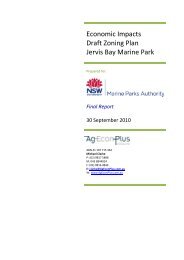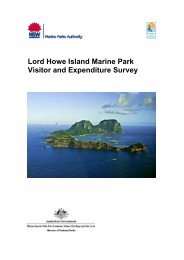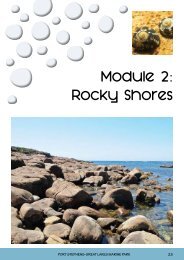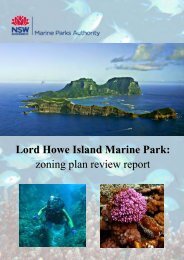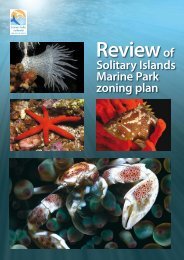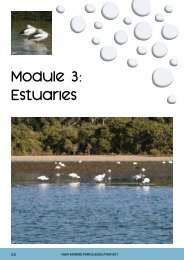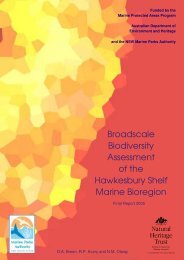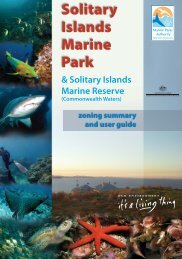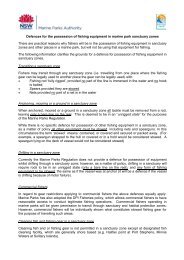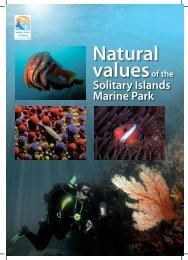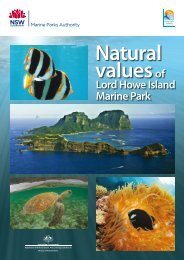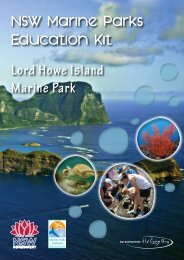Research Project Summaries 2002-2009 - Marine Parks Authority ...
Research Project Summaries 2002-2009 - Marine Parks Authority ...
Research Project Summaries 2002-2009 - Marine Parks Authority ...
Create successful ePaper yourself
Turn your PDF publications into a flip-book with our unique Google optimized e-Paper software.
SummaryBuilding a network of marine protected areas to comprehensively represent marinebiodiversity is a priority of the NSW Government, and to evaluate the effectiveness ofmarine parks through quality science is a high priority (NSW MPA 2004). Knowledge ofspatial distributions and changes in species, habitats, and ecosystem processes iscrucial to effective conservation planning and management. Specific impacts such aspollution, infrastructure development, pests and disease are also an important researchpriority. Information on social, economic and cultural values helps to understand andmanage conflict, improves consultation, education and compliance, and optimisesbenefits of marine parks to the community.<strong>Research</strong> projects conducted within the Solitary Islands <strong>Marine</strong> Park and Jervis Bay<strong>Marine</strong> Park over the review period <strong>2002</strong> to <strong>2009</strong> are directly relevant to marine parkplanning and management. These projects were conducted by the <strong>Marine</strong> <strong>Parks</strong><strong>Authority</strong> (MPA), supported financially or in-kind by the MPA, or carried out externallyto the MPA, primarily through universities. <strong>Research</strong> findings summarised in thisdocument came from all these sources.The MPA has conducted core programs to evaluate the effectiveness of the zoning andrelated management in fulfilling the objectives of the <strong>Marine</strong> <strong>Parks</strong> Act 1997 anddefined assessment criteria. Firstly, an acoustic seabed habitat mapping programprovided important information on the extent, distribution and structure of thesehabitats. Combining maps of seabed habitats from a number of sources withinformation on species composition has allowed improved assessment of theeffectiveness of zoning arrangements to represent biological diversity. For example, inthe Solitary Islands <strong>Marine</strong> Park, the current zoning plan uses a classification systembased on habitats, various depths, and elevation of reefs, as a surrogate forbiodiversity. Subsequent research indicated that species assemblages are stronglycorrelated with distance from shore and depth, and the current classification systemacknowledges this.To improve information on spatial patterns of biodiversity available for assessment ofzoning arrangements in the Solitary Islands <strong>Marine</strong> Park and Jervis Bay <strong>Marine</strong> Park,targeted surveys over the past seven years have built on surveys conducted beforedevelopment of the current zoning plan. In the Solitary Islands <strong>Marine</strong> Park, surveyshave focused on shallow and intermediate-depth reef fishes and molluscs primarilyoutside estuaries, macroinvertebrates in estuaries and other groups of fauna includingsome echinoderms and crustaceans at specific locations. Surveys in Jervis Bay <strong>Marine</strong>Park focused on fish, invertebrates and algae on shallow reefs and faunalassemblages (including polychaetes, molluscs and crustaceans) in estuarine softsedimenthabitats. Many of these projects were conducted over several years toexamine the effect of zoning on species diversity and abundance.Monitoring activities have also investigated specific impacts such as the effect ofmoorings on seagrass beds, introduced species, land use change, and causes andeffects of coral disease. In Jervis Bay <strong>Marine</strong> Park, research projects have alsoexamined the structure of pelagic fish assemblages and the distribution and behaviourof dolphins. Effects of zoning on recreational activities, including fishing, wereevaluated with long-term monitoring of usage patterns and recreational fishing catchrates. Visitor surveys throughout the Solitary Islands <strong>Marine</strong> Park also gave anassessment of the patterns of human use and visitor demographics and satisfaction.This diverse range of projects in the Solitary Islands <strong>Marine</strong> Park and Jervis Bay<strong>Marine</strong> Park aims to help evaluate of the effectiveness of the current zoning andiii



